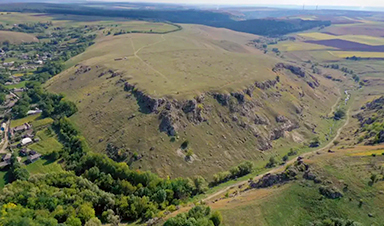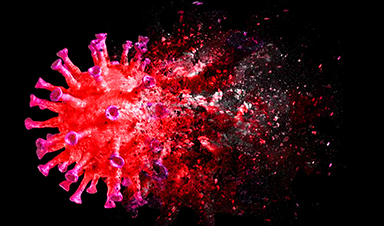Social distancing may have roots 6,000 years ago, as research shows Neolithic villages like Nebelivka used clustered layouts to control disease spread.
The phrase "social distancing" became widely recognized in recent years as people worldwide adapted their behavior to combat the COVID pandemic. However, new research led by UT Professor Alex Bentley suggests that the concept of maintaining organized physical distance may trace back roughly 6,000 years.
Bentley, from the Department of Anthropology, published a recent study in the Journal of The Royal Society Interface. His coauthors include Simon Carrignon, a former UT postdoctoral researcher who was a research associate at the Cambridge University's McDonald Institute for Archaeological Research while working on this project.
"New ancient DNA studies have shown that diseases such as salmonella, tuberculosis, and plague emerged in Europe and Central Asia thousands of years ago during the Neolithic Era, which is the time of the first farming villages," said Bentley. "This led us to ask a new question, which is whether Neolithic villagers practiced social distancing to help avoid the spread of these diseases."
Urban Planning Over the Centuries
As computational social scientists, Bentley and Carrignon have published on both ancient adaptive behaviors and the spread of disease in the modern world. This project brought these interests together. They found that the "mega-settlements" of the ancient Trypillia culture in the Black Sea region, circa 4,000 BC, were a perfect place to test their theory that boundaries of personal space have long been integral parts of public health planning.
They focused on a settlement called Nebelivka, in what is now Ukraine, where thousands of wooden homes were regularly spaced in concentric patterns and clustered in neighborhoods.
"This clustered layout is known by epidemiologists to be a good configuration to contain disease outbreaks," said Bentley. "This suggests and helps explain the curious layout of the world's first urban areas—it would have protected residents from emerging diseases of the time. We set out to test how effective it would be through computer modeling."
Carrignon and Bentley adapted models developed in a previous National Science Foundation-funded project at UT. Bentley was co-investigator with research lead Professor Nina Fefferman in this work modeling the effects of social distancing behaviors on the spread of Covid-like pandemics to study what effects these practices—such as reducing interaction between neighborhoods—might have had on prehistoric settlements.
"These new tools can help us understand what the archaeological record is telling us about prehistoric behaviors when new diseases evolved," said Bentley. "The principles are the same—we assumed the earliest prehistoric diseases were foodborne at first, rather than airborne."
Following the Trail
Their current study simulated the spread of foodborne disease, such as ancient salmonella, on the detailed plan of Nebelivka.
They teamed with:
- John Chapman and Bisserka Gaydarska, archaeologists from England's Durham University, who excavated Nebelivka;
- Brian Buchanan, a researcher at Eastern Washington University researcher who did a detailed digital map of the site;
- and Mike O'Brien, a cultural evolution expert from Texas A&M in San Antonio.
They ran the archeological data through millions of simulations to test the effects of different possible disease parameters.
"The results revealed that the pie-shaped clustering of houses at Nebelivka, in distinct neighborhoods, would have reduced the spread of early foodborne diseases," said Bentley. "Fighting disease might also explain why the residents of Nebelivka regularly burned their wooden houses to replace them with new ones. The study shows that neighborhood clustering would have helped survival in early farming villages as new foodborne diseases evolved."
Applications for Today
With their success in modeling from sparse archaeological data, this approach could be applied to contemporary and future situations when disease data are sparse, even for airborne illnesses.
"In the early 2020 days of the Covid epidemic, for example, few US counties were reporting reliable infection statistics," said Bentley. "By running millions of simulations with different parameter values, this approach—known as 'Approximate Bayesian Computation'—can be applied to test different models versus contemporary disease data, such as infection numbers in US counties over time."
The team's mix of ancient solutions and modern applications exemplifies the innovative approaches that Volunteer researchers in the College of Arts and Sciences bring to making lives better for Tennesseans and beyond.
Reference: "Modelling cultural responses to disease spread in Neolithic Trypillia mega-settlements" by R. Alexander Bentley, Simon Carrignon, Bisserka Gaydarska, John Chapman, Brian Buchanan and Michael J. O'Brien, 30 September 2024, Journal of the Royal Society Interface.
DOI: 10.1098/rsif.2024.0313
News
AI Helped Scientists Stop a Virus With One Tiny Change
Using AI, researchers identified one tiny molecular interaction that viruses need to infect cells. Disrupting it stopped the virus before infection could begin. Washington State University scientists have uncovered a method to interfere with a key [...]
Deadly Hospital Fungus May Finally Have a Weakness
A deadly, drug-resistant hospital fungus may finally have a weakness—and scientists think they’ve found it. Researchers have identified a genetic process that could open the door to new treatments for a dangerous fungal infection [...]
Fever-Proof Bird Flu Variant Could Fuel the Next Pandemic
Bird flu viruses present a significant risk to humans because they can continue replicating at temperatures higher than a typical fever. Fever is one of the body’s main tools for slowing or stopping viral [...]
What could the future of nanoscience look like?
Society has a lot to thank for nanoscience. From improved health monitoring to reducing the size of electronics, scientists’ ability to delve deeper and better understand chemistry at the nanoscale has opened up numerous [...]
Scientists Melt Cancer’s Hidden “Power Hubs” and Stop Tumor Growth
Researchers discovered that in a rare kidney cancer, RNA builds droplet-like hubs that act as growth control centers inside tumor cells. By engineering a molecular switch to dissolve these hubs, they were able to halt cancer [...]
Platelet-inspired nanoparticles could improve treatment of inflammatory diseases
Scientists have developed platelet-inspired nanoparticles that deliver anti-inflammatory drugs directly to brain-computer interface implants, doubling their effectiveness. Scientists have found a way to improve the performance of brain-computer interface (BCI) electrodes by delivering anti-inflammatory drugs directly [...]
After 150 years, a new chapter in cancer therapy is finally beginning
For decades, researchers have been looking for ways to destroy cancer cells in a targeted manner without further weakening the body. But for many patients whose immune system is severely impaired by chemotherapy or radiation, [...]
Older chemical libraries show promise for fighting resistant strains of COVID-19 virus
SARS‑CoV‑2, the virus that causes COVID-19, continues to mutate, with some newer strains becoming less responsive to current antiviral treatments like Paxlovid. Now, University of California San Diego scientists and an international team of [...]
Lower doses of immunotherapy for skin cancer give better results, study suggests
According to a new study, lower doses of approved immunotherapy for malignant melanoma can give better results against tumors, while reducing side effects. This is reported by researchers at Karolinska Institutet in the Journal of the National [...]
Researchers highlight five pathways through which microplastics can harm the brain
Microplastics could be fueling neurodegenerative diseases like Alzheimer's and Parkinson's, with a new study highlighting five ways microplastics can trigger inflammation and damage in the brain. More than 57 million people live with dementia, [...]
Tiny Metal Nanodots Obliterate Cancer Cells While Largely Sparing Healthy Tissue
Scientists have developed tiny metal-oxide particles that push cancer cells past their stress limits while sparing healthy tissue. An international team led by RMIT University has developed tiny particles called nanodots, crafted from a metallic compound, [...]
Gold Nanoclusters Could Supercharge Quantum Computers
Researchers found that gold “super atoms” can behave like the atoms in top-tier quantum systems—only far easier to scale. These tiny clusters can be customized at the molecular level, offering a powerful, tunable foundation [...]
A single shot of HPV vaccine may be enough to fight cervical cancer, study finds
WASHINGTON -- A single HPV vaccination appears just as effective as two doses at preventing the viral infection that causes cervical cancer, researchers reported Wednesday. HPV, or human papillomavirus, is very common and spread [...]
New technique overcomes technological barrier in 3D brain imaging
Scientists at the Swiss Light Source SLS have succeeded in mapping a piece of brain tissue in 3D at unprecedented resolution using X-rays, non-destructively. The breakthrough overcomes a long-standing technological barrier that had limited [...]
Scientists Uncover Hidden Blood Pattern in Long COVID
Researchers found persistent microclot and NET structures in Long COVID blood that may explain long-lasting symptoms. Researchers examining Long COVID have identified a structural connection between circulating microclots and neutrophil extracellular traps (NETs). The [...]
This Cellular Trick Helps Cancer Spread, but Could Also Stop It
Groups of normal cbiells can sense far into their surroundings, helping explain cancer cell migration. Understanding this ability could lead to new ways to limit tumor spread. The tale of the princess and the [...]





















